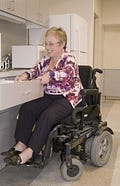People who have disabilities are just that—people. They want to live their lives, do their jobs, hang out with their friends and families, and be a part of things that matter to them.
If you have a disability yourself, or if a family member does, or if a coworker does, then you might be sensitized to be aware of assistive technology that makes a workplace accessible to people with sensory or mobility issues.
If you work for a large company, then you are probably already in compliance with federal and state guidelines. But if you are in a small firm that is not considered a “public accommodation” (e.g., restaurant, store, etc.), you might not be.
Make sure your company is in compliance with all legal responsibilities, of course. But also consider making some low-cost modifications that can make your company accessible and welcoming for clients and staff who might need them.
An obvious example is wheelchair access: can a person who uses a wheelchair navigate from the front door or parking lot to every part of the office? Consider curbs, doors that might close if not held open, narrow aisles between cubicles, etc. Even if there is no one employed in the office who is currently using a wheelchair, any of us could be one slip-on-the-ice away from several months using a wheelchair, crutches, or simply a moving dolly to get those files moved out without straining their back again. It’s a lot more stressful and frustrating to need to make the changes at that point.
Consider including Braille translations by the elevators and entryways.
Consider reserved parking spaces by the door for those with physical limitations.
Consider having remote meetings using a platform with real-time closed-captioning abilities.
Many of these are low-cost or free options, and they are worth including. Not only do they make your workplace more accessible and welcoming to people who use these accommodations, they also send the message to your team and your clients that your company is inclusive and considerate.
(Photo by CDC on Unsplash)
(info source: https://www.ada.gov/reachingout/smbusgd.pdf)


